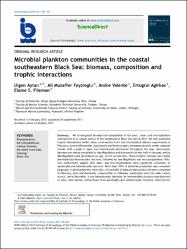| dc.contributor.author | Aytan, Ülgen | |
| dc.contributor.author | Feyzioğlu, Ali Muzaffer | |
| dc.contributor.author | Valente, Andre | |
| dc.contributor.author | Ağirbaş, Ertuğrul | |
| dc.contributor.author | Fileman, Elaine S. | |
| dc.date.accessioned | 2020-12-19T19:41:55Z | |
| dc.date.available | 2020-12-19T19:41:55Z | |
| dc.date.issued | 2018 | |
| dc.identifier.citation | Aytan, Ü., Feyzioğlu, A.M., Valente, A., Ağırbaş, E. & Fileman, E.S. (2018). Microbial plankton communities in the coastal southeastern Black Sea: biomass, composition and trophic interactions. Oceanologia, 60(2), 139-152. https://doi.org/10.1016/j.oceano.2017.09.002 | en_US |
| dc.identifier.issn | 0078-3234 | |
| dc.identifier.issn | 2300-7370 | |
| dc.identifier.uri | https://doi.org/10.1016/j.oceano.2017.09.002 | |
| dc.identifier.uri | https://hdl.handle.net/11436/1852 | |
| dc.description | Valente, Andre S. F. G./0000-0002-8789-7038; Feyzioglu, Ali Muzaffer/0000-0003-1171-5493; Agirbas, Ertugrul/0000-0001-7987-9668; Aytan, Ulgen/0000-0002-6530-3083 | en_US |
| dc.description | WOS: 000429649400006 | en_US |
| dc.description.abstract | We investigated biomass and composition of the pico-, nano-and microplankton communities in a coastal station of the southeastern Black Sea during 2011. We also examined trophic interactions within these communities from size-fractionated dilution experiments in February, June and December. Autotrophic and heterotrophic biomasses showed similar seasonal trends, with a peak in June, but heterotrophs dominated throughout the year. Autotrophic biomass was mainly comprised by nanoflagellates and diatoms in the first half of the year, and by dinoflagellates and Synechococcus spp. in the second half. Heterotrophic biomass was mostly dominated by heterotrophic bacteria, followed by nanoflagellates and microzooplankton. Dilution experiments suggest that nano-and microzooplankton were significant consumers of autotrophs and heterotrophic bacteria. More than 100% of bacterial production was consumed by grazers in all experiments, while 46%, 21% and 30% of daily primary production were consumed in February, June and December, respectively. in February, autotrophs were the main carbon source, but in December, it was heterotrophic bacteria. An intermediate situation was observed in June, with similar carbon flows from autotrophs and heterotrophic bacteria. Size-fraction dilution experiments suggested that heterotrophic nanoflagellates are an important link between the high heterotrophic bacterial biomass and microzooplankton. in summary, these results indicate that nano- and microzooplankton were responsible for comprising a significant fraction of total microbial plankton biomass, standing stocks, growth and grazing processes. This suggests that in 2011, the microbial food web was an important compartment of the planktonic food web in the coastal southeastern Black Sea. (C) 2017 Institute of Oceanology of the Polish Academy of Sciences. Production and hosting by Elsevier Sp. z o.o. | en_US |
| dc.description.sponsorship | Karadeniz Technical UniversityKaradeniz Technical University [2009.117.001.6] | en_US |
| dc.description.sponsorship | This study was funded by Research Fund of Karadeniz Technical University (Grant No: 2009.117.001.6). We are extremely grateful to Dr. Angus Atkinson for his constructive comments and Prof. Dr. Hasan Baha Buyukisik for technical advice on experimental design and valuable discussions in the course of this study. We are grateful to the captains and crew of r/v Denar for their cooperation at sea. We also thank the anonymous reviewers for their constructive comments. | en_US |
| dc.language.iso | eng | en_US |
| dc.publisher | Polish Acad Sciences Inst Oceanology | en_US |
| dc.rights | info:eu-repo/semantics/closedAccess | en_US |
| dc.subject | Phytoplankton | en_US |
| dc.subject | Microzooplankton | en_US |
| dc.subject | Carbon biomass | en_US |
| dc.subject | Microbial food web | en_US |
| dc.subject | Grazing | en_US |
| dc.subject | Black Sea | en_US |
| dc.title | Microbial plankton communities in the coastal southeastern Black Sea: biomass, composition and trophic interactions | en_US |
| dc.type | article | en_US |
| dc.contributor.department | RTEÜ, Su Ürünleri Fakültesi, Su Ürünleri Temel Bilimler Bölümü | en_US |
| dc.contributor.institutionauthor | Aytan, Ülgen | |
| dc.contributor.institutionauthor | Ağirbaş, Ertuğrul | |
| dc.identifier.doi | 10.1016/j.oceano.2017.09.002 | |
| dc.identifier.volume | 60 | en_US |
| dc.identifier.issue | 2 | en_US |
| dc.identifier.startpage | 139 | en_US |
| dc.identifier.endpage | 152 | en_US |
| dc.ri.edit | oa | en_US |
| dc.relation.journal | Oceanologia | en_US |
| dc.relation.publicationcategory | Makale - Uluslararası Hakemli Dergi - Kurum Öğretim Elemanı | en_US |


















